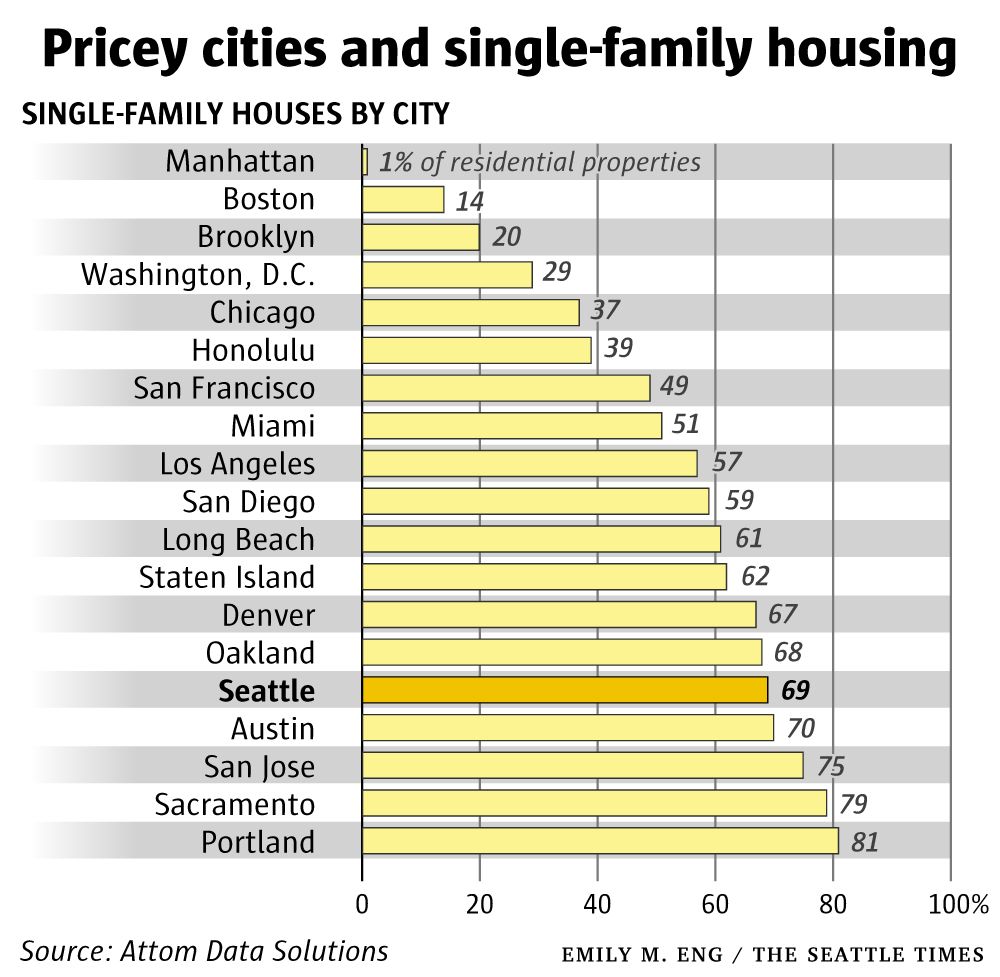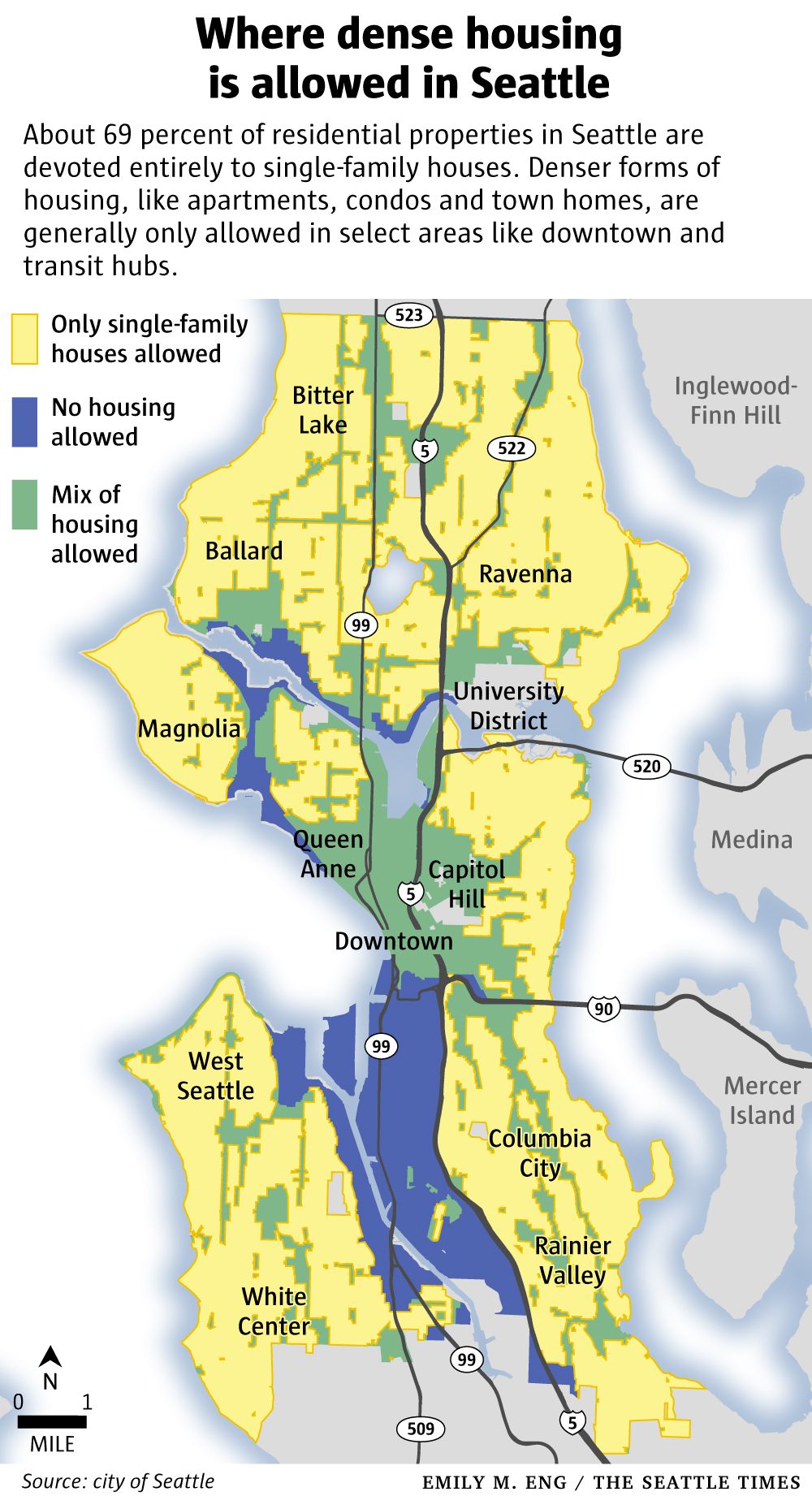Another backgrounder on the housing dilemma from the Seattle Times. And just so you know, it’s estimated that 80 percent of residential land in Vancouver is zoned for ‘single-family’ — a misleading term, since it doesn’t define family, and almost every sf-home in Vancouver can have multiple units via secondary suites and lane houses. But you get the idea — they’re low-density, separated and super-expensive.
Rapidly growing Seattle constrains new housing through widespread single-family zoning
This is the second edition of real-estate reporter Mike Rosenberg’s new housing column, which takes a deeper dive into the booming housing market and answers reader questions. Read the first instalment here.
In Seattle, 69 percent of residential plots of land are occupied by single-family houses, according to Attom Data Solutions, which has an extensive nationwide property database and ran the numbers for me. That’s about average when looking at the 50 biggest cities in the country. But compared to other peer cities with expensive housing, Seattle generally devotes a lot more of its housing to single-family homes:

… In Seattle, tall, dense buildings are generally allowed in the greater downtown region and in outlying areas near transit (think downtown Ballard or the West Seattle Junction). The majority of land – everything in yellow in this map – is restricted exclusively to single-family homes:

… Last year, 88 percent of the city’s new housing was crowded into dense neighborhoods that make up just 18 percent of the city’s residential land area (the pink zones here):

… On average, it takes at least seven new homes on one property before each one is cheaper than the older, single house it replaced, the Sightline Institute found. …. Essentially Seattle has managed to get the bad parts of a luxury housing boom without reaping any of the benefits of a housing-supply boom.
To have a real impact on affordability, Seattle would need to build a lot more of these smaller homes in taller buildings – a complete overhaul to neighborhoods that existing homeowners (the majority of city voters) are likely to oppose. This is why the city has only tiptoed around relatively small changes to single-family neighborhoods (a few years ago, a proposal to add much more density to single-family zones was so poorly received by homeowners it was dropped in a matter of weeks). …
Even now, all the upzones the city has proposed and is considering enacting in the coming months would affect just 6 percent of the city’s single-family zones – the current plan would generally just allow taller buildings in areas where some density is already allowed.
Full story here.













This story is nearly a mirror image of Metro Vancouver’s dilemma: A chronic land shortage. Mountain Math did some very similar calculations and mapping and found roughly 10% more land is in lockdown from zoning for low density residential than even Seattle. Artificially constraining land means only one direction is possible for prices: Up. It’s not all about foreign buyers.
It is a political challenge because of the NIMBY effect, but a little courage could go a long way when new (to Vancouver) forms of single-family and two-family family housing emerge and are quickly gobbled up because they are cheaper than detached housing while maintaining their ground orientation, and often a small garden.
The narrative here focuses on the growing gulf between incomes and housing prices. So let’s do both: Bring housing prices down by shaving away a part of the expensive land it is connected to, and by increasing supply; and bring family incomes up by building a rental suite into most of the houses.
This could be timed with he arrival of new transit infrastructure and publicly-funded rental housing.
This does sound like what the city is doing in the third phase of the Cambie Corridor plan. The first phases being even higher density.
I haven’t looked at Phase 3 yet. I certainly hope they are considering upzoning the hundreds of 50-foot lots buried several blocks in from Cambie and Oak, and fostering fee simple single family attached housing.
They’re definitely rezoning almost everything between Oak and Columbia: http://dailyhive.com/vancouver/cambie-corridor-plan-approved-vancouver-2018